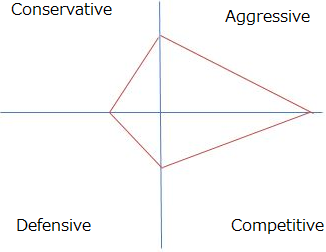Types of Strategies
Although there are many methodologies in business management (Kanban, Scrum, Agile, and others), three main strategies stand out very clearly, separated from each other by the principle of orientation. The first strategy is to focus on client requests and feedbacks. This strategy model is renowned for its flexibility, as client requests can change over time (Scott, 2013). The example of Commonwealth Brewery and, in general, the alcohol business and production depends on public sentiment. Even though Commonwealth Brewery has a non-alcoholic segment, which is profitable and popular with customers, the alcohol business can suffer losses. According to generational theory, millennials tend to consume less alcohol or drink expensive alcohol, as many are interested in healthy eating and lifestyle (Roach, 2017). Generation Z, very young consumers, students, or non-professional workers who have to gain experience in life, prefer drinks with a sweeter taste, similar to cocktails (Roach, 2017). Thus, for example, beer like Heineken fades into the background among the younger generation.
The second strategy is operational and consists of the fact that managers are more focused on the internal processes and capabilities of the team. It is impossible to eliminate the second strategy from any production or service business plan since the team’s real work is the key to a quality product (Scott, 2013). In the Commonwealth Brewery example, though, the focus is on the customer, assuming that the second strategy is kept to a minimum. Transformation strategy is fundamental in the business of Commonwealth Brewery, as production is very dependent not much on the mechanisms (although this is the case) but on creating a digital model. In particular, people are talking about the convenient management of complex accounting and payment for services and products. Given Commonwealth Brewery’s diverse customer base, it is easy to assume that each group of customers will expect different payment methods.
The SPACE Matrix
The SPACE matrix of the business in question is presented by analyzing market competition, segment attractiveness, financial strength, and environmental stability. Commonwealth Brewery has many competitors, but they adequately occupy their fair niche, which does not pose any risks to their business. The company provides an extensive range of drinks, which can be both a strength and a weakness (Müller, 2019). Commonwealth Brewery is developing in a desirable segment; however, as the experience of COVID-19 has shown, the pandemic can significantly affect the use of alcohol and lemonade drinks and cocktails. Bars, for example, may cease to receive visitors, respectively the need for most purchases of alcohol will disappear. The company has relatively high financial strength as it attracts investors. Environmental stability is increased with the company in question, as they have been on the market long. The SPACE matrix shows that Commonwealth Brewery belongs to a competitive business and combines forms of aggressive business, as it has a large flow of customers of different ages. Usually, Commonwealth Brewery does not have to defend itself against competitors, government regulations, or customers, and the market environment is generally calm.

Strategy Implementation
The annual goals do not look global but are based on the distribution of the company’s products worldwide and the increase in foreign supplies. The company’s policy is based on developing its technologies and personnel; HRs are constantly recruiting new people to the team. In addition, the company has a historical responsibility, as Commonwealth Brewery is representative of the famous Heineken brand, which is popular in countries with different economies and populations. The distribution of resources is aligned with annual goals: resources are logically distributed across countries without influencing aspects of personal likes or dislikes. Conflict management in the company is put on the shoulders of HR specialists, about whom the most necessary information is presented in detail. Conflicts can arise in achieving annual goals, as managers of different departments see the further development of Commonwealth Brewery through their education and experience. In addition, given the size of the company, cultural conflicts are inevitable, and HRs, as coaches and psychologists, should be aware of this. Usually, if serious disputes arise, it is possible to involve third-party mediators or coaches.
Structural changes go hand in hand with new business planning and management models. David (2010) states that “structure dictates how resources will be allocated” (p. 221). Structural changes simultaneously affect all aspects of the life of the company and the interaction of departments. These changes affect the structure of divisions, as divisions depend on each other. They count on the decisions of managers, HRs, and directors. The company under consideration has a decentralized structure; that is, there are a lot of departments that share responsibility among themselves. Directors can achieve advancement in the company’s management by transferring more powers to managers of individual departments.
Recommendations
The main recommendations are considered to be the active hiring of certified specialists in marketing and the food industry. The development of advertising is necessary, which will give inspiration to employees and product creators. Although Commonwealth Brewery is a well-known company with a long history of work, it, like the rest, needs advertising, including on the Internet; modern marketing has changed, moving into the digital age (Chawla et al., 2018). Concentrating on the older generation or mature consumers, perhaps Commonwealth Brewery forgets about those who have just crossed the threshold with which it is already allowed to drink alcohol.
References
Chawla, V., Chanda, A., Angra, S., & Chawla, G. (2018). The sustainable project management: A review and future possibilities. Journal of Project Management, 3, 157–170. Web.
David, F. R. (2010). Strategic management: Concepts and cases (13th ed.). Pearson College Div.
Müller, R., Drouin, N., & Sankaran, S. (2019). Modeling organizational project management. Project Management Journal, 50(4), 499–513. Web.
Roach, T. (2017). Five best practices for managing your brewery’s cash flow. Craft Brewing Business. Web.
Scott, J. (2013). What are the three types of strategy in business? Accelerate. Web.